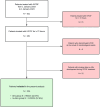Adverse events during intravenous fosfomycin therapy in a real-life scenario. Risk factors and the potential role of therapeutic drug monitoring
- PMID: 38943088
- PMCID: PMC11212171
- DOI: 10.1186/s12879-024-09541-4
Adverse events during intravenous fosfomycin therapy in a real-life scenario. Risk factors and the potential role of therapeutic drug monitoring
Abstract
Background: Intravenous fosfomycin (IVFOF) is gaining interest in severe infections. Its use may be limited by adverse events (AEs). Little experience exists on IVFOF therapeutic drug monitoring (TDM) in real-life setting.
Patients and methods: Retrospective study of patients receiving IVFOF for > 48 h at Policlinico Hospital (Milan, Italy) from 01/01/2019 to 01/01/2023. AEs associated to IVFOF graded CTCAE ≥ II were considered. Demographic and clinical risk factors for IVFOF-related AEs were analysed with simple and multivariable regression models. The determination of IVFOF TDM was made by a rapid ultraperformance liquid chromatography mass spectrometry method (LC-MS/MS) on plasma samples. The performance of TDM (trough levels (Cmin) in intermittent infusion, steady state levels (Css) in continuous infusion) in predicting AEs ≤ 5 days after its assessment was evaluated.
Results: Two hundred and twenty-four patients were included. At IVFOF initiation, 81/224 (36.2%) patients were in ICU and 35/224 (15.7%) had septic shock. The most frequent infection site was the low respiratory tract (124/224, 55.4%). Ninety-five patients (42.4%) experienced ≥ 1AEs, with median time of 4.0 (2.0-7.0) days from IVFOF initiation. Hypernatremia was the most frequent AE (53/224, 23.7%). Therapy discontinuation due to AEs occurred in 38/224 (17.0%). ICU setting, low respiratory tract infections and septic shock resulted associated with AEs (RRadjusted 1.59 (95%CI:1.09-2.31), 1.46 (95%CI:1.03-2.07) and 1.73 (95%CI:1.27-2.37), respectively), while IVFOF daily dose did not. Of the 68 patients undergone IVFOF TDM, TDM values predicted overall AEs and hypernatremia with AUROC of 0.65 (95%CI:0.44-0.86) and 0.91 (95%CI:0.79-1.0) respectively for Cmin, 0.67 (95%CI:0.39-0.95) and 0.76 (95%CI:0.52-1.0) respectively for Css.
Conclusions: We provided real world data on the use of IVFOF-based regimens and associated AEs. IVFOF TDM deserves further research as it may represent a valid tool to predict AEs.
Key points: Real world data on intravenous fosfomycin for severe bacterial infections. AEs occurred in over 40% (therapy discontinuation in 17%) and were related to baseline clinical severity but not to fosfomycin dose. TDM showed promising results in predicting AEs.
Keywords: Adverse events; Antimicrobial resistance; Intravenous fosfomycin disodium; Multidrug resistance; TDM; Toxicity.
© 2024. The Author(s).
Conflict of interest statement
The authors declare no competing interests.
References
-
- Falagas ME, Kastoris AC, Kapaskelis AM, Karageorgopoulos DE. Fosfomycin for the treatment of multidrug-resistant, including extended-spectrum β-lactamase producing, Enterobacteriaceae infections: a systematic review. Lancet Infect Dis. 2010;10:43–50. doi: 10.1016/S1473-3099(09)70325-1. - DOI - PubMed
-
- Kaye KS, Rice LB, Dane AL, Stus V, Sagan O, Fedosiuk E, et al. Fosfomycin for Injection (ZTI-01) Versus Piperacillin-Tazobactam for the treatment of complicated urinary tract infection including Acute Pyelonephritis: ZEUS, a phase 2/3 Randomized Trial. Clin Infect Dis. 2019;69:2045–56. doi: 10.1093/cid/ciz181. - DOI - PMC - PubMed


